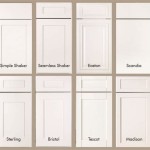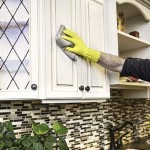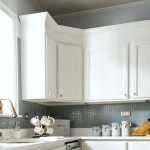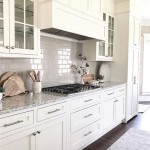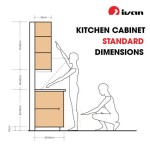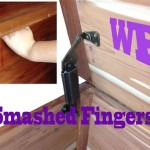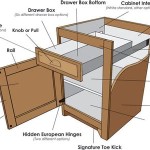Cost of Refinishing Kitchen Cabinets: A Comprehensive Guide
Refinishing kitchen cabinets represents a viable alternative to complete cabinet replacement, offering a cost-effective method to refresh the appearance of a kitchen without incurring significant expenses. Understanding the various factors influencing the cost, as well as the different refinishing options available, is crucial for homeowners considering this project. The overall cost is dependent on the size and material of the cabinets, the complexity of the finish, and whether the project is undertaken as a DIY venture or contracted to professional refinishers. This document aims to provide a comprehensive overview of the costs associated with kitchen cabinet refinishing, examining the various influencing factors and providing insights into budgeting and decision-making.
Factors Influencing the Cost of Kitchen Cabinet Refinishing
Several factors contribute to the final cost of refinishing kitchen cabinets. These elements must be carefully considered to accurately estimate the project budget and make informed decisions about the scope and materials used. These factors typically fall under three broad categories: cabinet size and material, refinishing method and complexity, and labor costs (if applicable).
Cabinet Size and Material: The size of the kitchen and the number of cabinets directly correlate with the amount of labor and materials required for the refinishing process. A larger kitchen with numerous cabinets will naturally demand more paint, stain, and other finishing products, thereby increasing the overall cost. Similarly, the type of material the cabinets are made from impacts the cost. Solid wood cabinets, while often more durable, may require more extensive preparation and specialized products compared to cabinets constructed from laminate or MDF (Medium-Density Fiberboard). Refinishing wood cabinets typically involves sanding down the existing finish, applying primer, and then applying the new finish. Laminate cabinets may require specialized primers and paints designed to adhere to non-porous surfaces. The existing condition of the cabinets also plays a crucial role. Cabinets with significant damage, such as dents, scratches, or water damage, will necessitate additional repair work before the refinishing process can begin, further adding to the overall cost.
Refinishing Method and Complexity: The chosen refinishing method directly impacts the cost. Simple refinishing, which involves cleaning, sanding, and applying a fresh coat of paint or stain, is generally the least expensive option. However, more complex techniques, such as applying multiple layers of glaze, distressing the finish for an antique look, or completely changing the color of the cabinets, will require more time, specialized materials, and potentially more skilled labor. For instance, applying a glaze requires a steady hand and a good understanding of color blending to achieve the desired effect. Distressing techniques, which involve intentionally damaging the finish to create a weathered appearance, also require specific tools and techniques. The type of finish chosen also affects the cost. High-end paints or stains, particularly those with specialized properties like moisture resistance or UV protection, will be more expensive than standard options. Furthermore, the application method, whether brushing, rolling, or spraying, can influence the cost. Spraying typically provides the smoothest and most professional finish but requires specialized equipment and a controlled environment to prevent overspray.
Labor Costs: If the homeowner chooses to hire professional refinishers, labor costs will be a significant component of the overall project budget. Labor costs vary depending on the location, the experience and expertise of the refinishers, and the complexity of the project. Some refinishers charge by the hour, while others provide a fixed price quote for the entire project. It is crucial to obtain multiple quotes from different refinishers and carefully compare the services included in each quote. Ensure that the quote includes all necessary preparation work, such as sanding, cleaning, and priming, as well as the application of the chosen finish. Also, clarify whether the quote includes the cost of materials or if these are billed separately. When evaluating quotes, it is important to consider not only the price but also the refinisher's reputation, experience, and references. Checking online reviews and asking for referrals from past clients can provide valuable insights into the quality of their work. Consider the cost of removing and reinstalling the cabinet doors and hardware. Some refinishers include this in their standard service, while others charge an additional fee. Detaching and reattaching the hardware can be time-consuming, and it is important to ensure that it is done correctly to avoid damaging the cabinets or hardware.
Refinishing Options and Associated Costs
Several options exist for refinishing kitchen cabinets, each with varying costs and levels of complexity. The choice depends on the homeowner's budget, desired aesthetic, and skill level if undertaking the project as a DIY venture. These options can be broadly categorized as painting, staining, and specialty finishes.
Painting: Painting kitchen cabinets is a popular and relatively cost-effective way to update their appearance. The cost of painting depends on the type of paint used, the number of coats required, and whether the cabinets are being painted by the homeowner or a professional. Latex paint is a common choice for kitchen cabinets due to its durability and ease of cleaning. Oil-based paint offers a harder, more durable finish but requires more effort to apply and clean up. The preparation process is crucial for achieving a smooth and long-lasting paint finish. This typically involves cleaning the cabinets thoroughly, sanding them to create a smooth surface, and applying a primer to improve paint adhesion. Some paints are specifically formulated for use on cabinets and require minimal preparation. These paints often contain self-priming properties and are designed to resist chipping and peeling. However, they may be more expensive than standard paints. When choosing a paint color, consider the overall style of the kitchen and the desired mood. Light colors can brighten up a dark kitchen, while darker colors can add drama and sophistication. It is also important to choose a paint finish that is appropriate for kitchen cabinets. Semi-gloss or gloss finishes are easier to clean than matte finishes and are more resistant to moisture and stains.
Staining: Staining kitchen cabinets can enhance the natural wood grain and add warmth to the kitchen. The cost of staining depends on the type of stain used, the number of coats required, and the complexity of the staining process. Wood stains are available in a wide range of colors and shades, allowing homeowners to customize the look of their cabinets. Penetrating wood stains are designed to soak into the wood fibers, highlighting the natural grain and adding depth to the finish. Gel stains are thicker than penetrating stains and are ideal for use on non-porous surfaces or when a more uniform color is desired. The preparation process for staining is similar to that for painting, involving cleaning and sanding the cabinets to create a smooth surface. However, it is particularly important to remove any existing finish completely to ensure that the stain penetrates the wood evenly. Applying a wood conditioner before staining can help to prevent blotchiness and ensure a more uniform color. After staining, it is important to apply a protective topcoat to seal the stain and protect the cabinets from moisture and wear. Polyurethane is a popular choice for a topcoat due to its durability and moisture resistance. Water-based polyurethane is a good option for light-colored stains as it is less likely to yellow over time than oil-based polyurethane.
Specialty Finishes: Specialty finishes, such as glazing, distressing, and antiquing, can add character and unique style to kitchen cabinets. These techniques typically involve applying multiple layers of paint or stain and using specialized tools to create the desired effect. Glazing involves applying a thin layer of tinted glaze over the base coat of paint, highlighting the details and adding depth to the finish. Distressing involves intentionally damaging the finish to create a weathered or aged appearance. This can be achieved by sanding, chipping, or scratching the paint. Antiquing involves applying a dark wax or stain to the cabinets and then wiping it away in certain areas to create a vintage look. These specialty finishes require more skill and time than standard painting or staining and are typically best left to professional refinishers. The cost of specialty finishes can vary widely depending on the complexity of the technique and the materials used. However, they can add significant value and visual appeal to the kitchen.
DIY vs. Professional Refinishing: Cost Considerations
The decision to refinish kitchen cabinets as a DIY project or hire professional refinishers hinges on several factors, including the homeowner's skill level, available time, and budget. A DIY project can potentially save money on labor costs, while professional refinishing offers the advantage of expertise, efficiency, and a guaranteed quality finish.
DIY Refinishing: The primary cost saving of DIY refinishing lies in the elimination of labor costs. However, it is crucial to factor in the cost of tools and materials. This includes sandpaper, primer, paint or stain, brushes or rollers, cleaning supplies, and safety equipment such as respirators and gloves. If specialized equipment, such as a paint sprayer, is desired, the cost could increase further. A significant consideration is the time commitment involved. Refinishing kitchen cabinets is a time-consuming process that requires meticulous preparation, careful application of the finish, and adequate drying time. The homeowner must be prepared to dedicate several days or even weeks to the project, depending on the size of the kitchen and the complexity of the chosen finish. The quality of the finish is directly related to the homeowner's skill and experience. Novices may struggle to achieve the same level of smoothness and consistency as professional refinishers. Mistakes can be costly, as they may require additional sanding, repainting, or even replacing damaged cabinets. Furthermore, improper ventilation during the refinishing process can pose health risks due to the fumes from paints and stains. It is essential to work in a well-ventilated area and to wear appropriate respiratory protection. Finally, consider the disposal of waste materials, such as used paint cans and sanding dust. Some communities have specific regulations regarding the disposal of these materials, and it is important to comply with these regulations.
Professional Refinishing: Hiring professional refinishers offers the advantage of expertise, efficiency, and a guaranteed quality finish. Professionals have the experience and equipment necessary to handle all aspects of the refinishing process, from preparation to final coat. They can also provide valuable advice on color selection, finish options, and other design considerations. While professional refinishing is more expensive than DIY refinishing, it can save time and stress. Professionals can typically complete the project in a fraction of the time it would take a homeowner, minimizing disruption to the kitchen. The cost of professional refinishing varies depending on the location, the experience and expertise of the refinishers, and the complexity of the project. It is important to obtain multiple quotes from different refinishers and carefully compare the services included in each quote. A reputable refinisher will provide a detailed written estimate that outlines all costs involved, including labor, materials, and any additional fees. Before hiring a refinisher, check their references and read online reviews to ensure they have a good track record. Ask to see examples of their previous work and inquire about their warranty policy. A professional refinisher should be able to provide a warranty that covers defects in materials or workmanship. Consider the inconvenience of having the kitchen unavailable during the refinishing process. Professional refinishers typically require access to the kitchen for several days and may need to remove the cabinet doors and hardware. Discuss the timeline with the refinisher and make arrangements for alternative cooking and food preparation areas. Finally, ensure that the refinisher is properly licensed and insured. This protects the homeowner from liability in case of accidents or damage during the project.
Budgeting and Cost-Saving Tips
Effective budgeting and strategic cost-saving measures are crucial for a successful kitchen cabinet refinishing project. Careful planning and informed decision-making can help homeowners achieve their desired aesthetic within a reasonable budget.
Detailed Planning: Before commencing the project, create a detailed plan that outlines the scope of work, the materials required, and the estimated costs. This plan should include a realistic assessment of the homeowner's skill level, available time, and budget. Obtain multiple quotes from different refinishers and carefully compare the services included in each quote. Read online reviews and check references to ensure the refinisher has a good reputation. Research different paint and stain options and compare prices. Consider purchasing materials in bulk to save money. Prepare the cabinets thoroughly before applying the finish. This includes cleaning, sanding, and priming. Proper preparation can significantly improve the quality and longevity of the finish, reducing the need for costly repairs or refinishing in the future. Protect the surrounding areas from paint or stain splatters by covering them with drop cloths or plastic sheeting. This can prevent costly cleanup and repair work.
Cost-Saving Strategies: One strategic cost-saving measure involves performing as much of the work as possible independently, such as removing cabinet doors and hardware, cleaning the cabinets, and preparing the work area. This can significantly reduce the labor costs if hiring professional refinishers. Consider using less expensive paint or stain options. While high-end products may offer superior durability or aesthetics, standard options can still provide a good quality finish at a lower cost. Choose a simple finish, such as a single coat of paint or stain. Complex finishes, such as glazing or distressing, require more time and materials and can significantly increase the cost of the project. Avoid making significant structural changes to the cabinets, such as adding new doors or drawers. These changes can be costly and time-consuming. Instead, focus on updating the existing cabinets with a fresh finish and new hardware. Consider refinishing only the cabinet doors and drawer fronts. This can significantly reduce the amount of labor and materials required, especially if the cabinet boxes are in good condition. Shop around for the best prices on materials. Compare prices at different hardware stores and online retailers. Look for sales and discounts. Consider using recycled or reclaimed materials. For example, you can use reclaimed wood to create new cabinet doors or drawer fronts. Clean up thoroughly after the project is completed. This can prevent costly cleanup fees.
Prioritizing Quality: While cost savings are important, it is also crucial to prioritize quality. Choosing inferior materials or cutting corners on preparation can lead to a substandard finish that will not last as long and may require costly repairs or refinishing in the future. Invest in high-quality paintbrushes and rollers. These tools will provide a smoother and more even finish. Use a good quality primer to improve paint adhesion and prevent bleed-through. Apply multiple thin coats of paint or stain rather than one thick coat. This will result in a more durable and professional-looking finish. Allow the paint or stain to dry completely between coats. This will prevent drips and runs. Protect the finished cabinets from scratches and damage by using coasters and placemats. Clean the cabinets regularly with a mild detergent and water. Avoid using harsh chemicals or abrasive cleaners. By carefully balancing cost savings with quality considerations, homeowners can achieve a beautiful and long-lasting kitchen cabinet refinish that enhances the value and enjoyment of their home.

Kitchen Cabinet Painting Cost 2024

What Is The Cost To Paint My Kitchen Cabinets Ramsden Painting

How Much Does Kitchen Cabinet Painting Cost The Picky Painters Berea Oh

How Much Does It Cost To Spray Paint Kitchen Cabinets

Cabinet Refacing Process And Cost Compared To Painting

How Much Does It Cost To Refinish Cabinets N Hance

How Much Does It Cost To Spray Paint Kitchen Cabinets Sketch

Cost Difference For Refinishing Re Facing And Brooks Painting

Benefits Of Refacing Kitchen Cabinet

How Much Does Cabinet Refacing Cost 2024 S Homeguide
Related Posts

